The big story of Notre Dame/Pitt was, once again, the Irish not seeming to be able to get out of their own way, especially on offense. We’ve all wondered why we seem to cough up the ball so often and against Pitt, Rees was the major culprit. While other people didn’t help around him, Rees could have prevented each turnover on his own. The mistakes made are beyond frustrating, but, if Rees is the QB that Kelly believes is the best to lead this team, all of these mistakes can and should be corrected.
I do want to put out a disclaimer that the goal of this post isn’t to bash Rees or suggest that we have a better option. I don’t watch practices and I only have a single half of video footage of any other QB play. The purpose of this post is to breakdown the comments I made all game long on Twitter (and the analysts on ESPN made as well) that Rees was “locked in” and “wasn’t seeing the field properly”. Such statements are easy to throw out, but being able to break down the footage helps to highlight exactly where Rees went wrong and why I damn near pull my hair out on such mistakes.
Let’s start with the opening drive. Right before the Irish were forced to punt, Rees threw a near INT after a overthrow of Riddick. This play ends up being a great example of Rees locking on to his target and Pitt selling out in coverage on that fact.
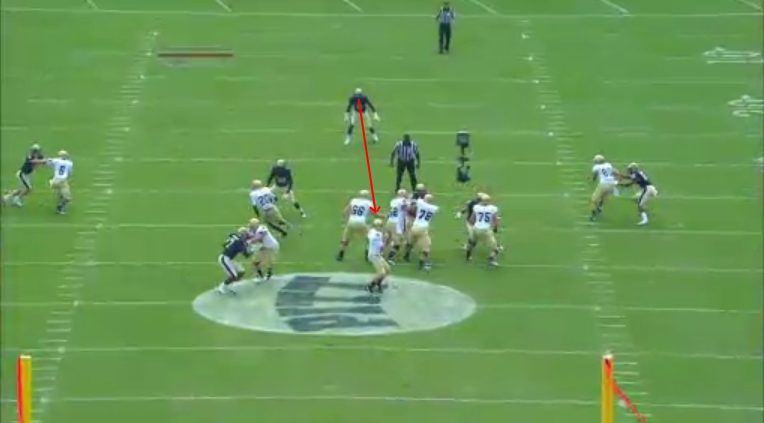
Just after the snap, you can see that Rees has two receivers running down the middle of the field, with only one safety to help. That safety is watching only one thing: Rees’ eyes. Once Rees looks to a receiver the safety will then decide which man to cover and which man to leave open.
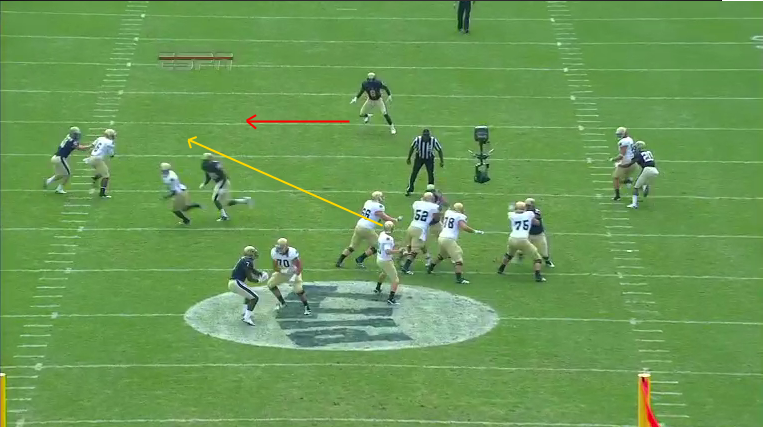
Rees immediately looks to Riddick and starts his throwing motion. The safety makes his decision and starts to move Riddick’s direction. By doing this though, Eifert is now open against single coverage on the right side, which Rees never sees. Had Rees used his eyes to look the safety off or even did a pump fake, we easily have the potential for a big play. It wasn’t like Rees had to hurry and make a throw either, just look at the protection around him.
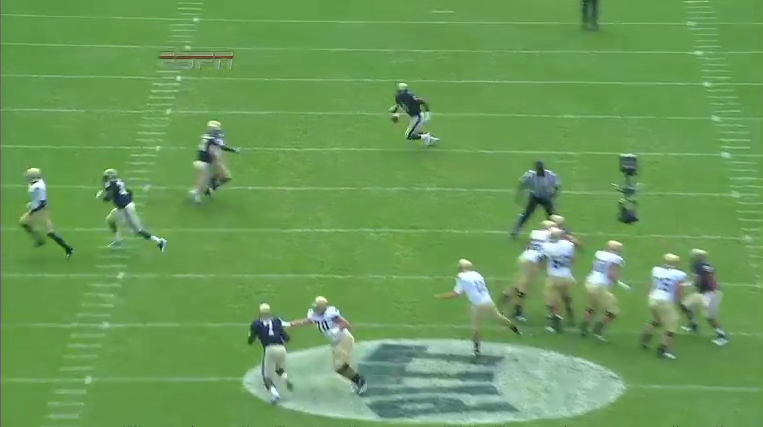
And now we get the eventual result. The CB on Riddick is actually able to adjust to the route and cuts off the window Rees initially thought he had. With the safety also coming over the top, this pass just became near impossible to complete. The throw happens to be overthrown in this instance and would’ve been picked off had Riddick not gotten a piece of the ball. Rees made a bad decision here and focused far too much on his primary read instead of making the easy adjustment to Eifert’s route.
Next, we take a look at the first turnover of the game, Rees’ fumble.
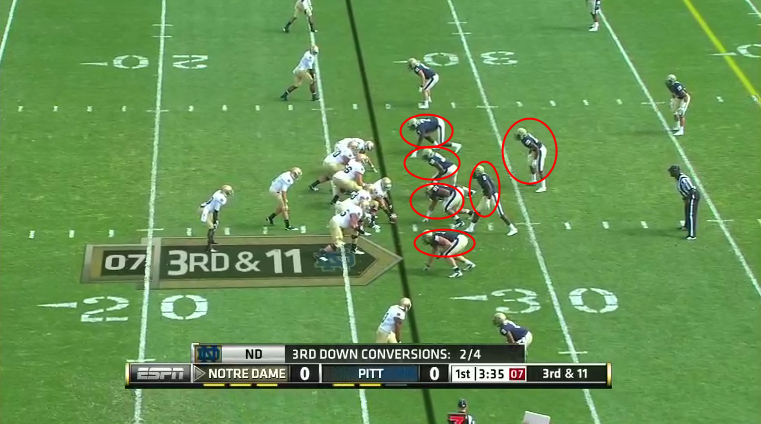
Before the snap Rees reads a blitz and throws out an audible. He sees for sure at least two LB blitzing as one is lined up with the D-line and another creeping right behind them. The final LB circled behind the 30 was also creeping back and forth as well. Rees sees the potential for six pass rushers to be coming at him at once.
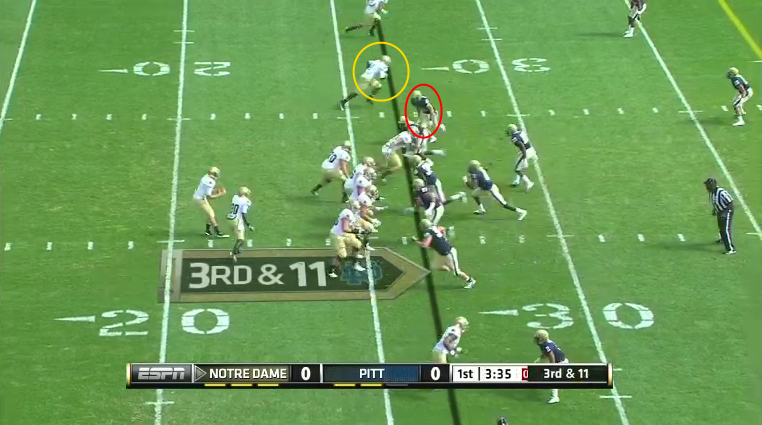
The ball is then snapped and it’s obvious that Rees has misread the blitz package. Six men are indeed rushing, but the CB circled in red is the blitzer that Rees never saw. However, missing the pre-snap read isn’t the end of the world. The CB blitz has left Riddick wide open as the hot route and all Rees has to do is adjust and see it.
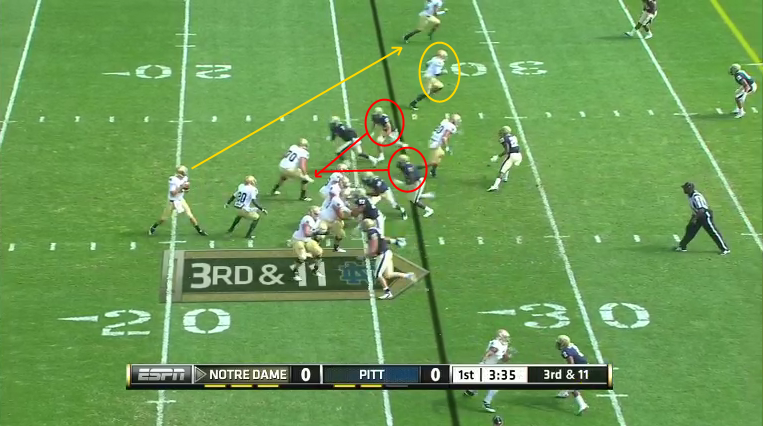
We come to our next problem in this play and this time it’s the blocking. The four offensive linemen toward the bottom are engaged on only three pass rushers, leaving the two blitzers circled in red free to shoot the huge gap created by the initial rush. Cierre Wood is now stuck in an impossible situation and must at least take care of one blitzer to give Rees enough time to get rid of the ball. Riddick, circled in yellow, literally has no one around him; however, Rees doesn’t see this as he is locked into the receiver to Riddick’s left. Rees is still operating off his pre-snap read and believes that the blitz up the middle is going to leave single coverage for his receiver down the sideline.
Wood takes out the closest blitzer and Rees needs to make his decision now on his throw. He has the entire yellow circled area by Riddick to throw to safely; however, he still doesn’t see it despite looking in that direction down the field. He is still looking past the correct read and is waiting for the other route he was previously staring down to develop.
The route that Rees was previously staring down didn’t develop to his liking and Rees then makes another critical error that eventually buries him. He somehow doesn’t see the wide open Riddick and actually turns his vision to the other side of the field towards Floyd, whom, according to his presnap read should have single coverage as well. Rees has exposed his blindside to the CB he never saw coming presnap, and based on his reactions during this play, never saw at all. Rees continues to stare down Floyd as he is sacked and stripped of the football.
Now let’s move on to the INT, a play which should have been a touchdown.
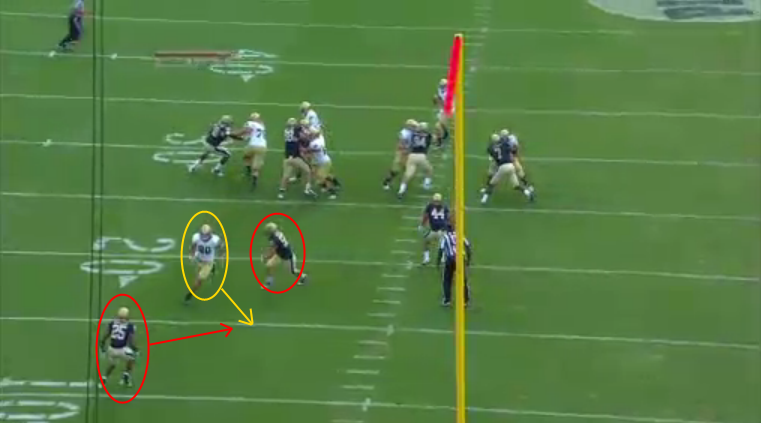
This play is called to Eifert and, while ESPN would later criticize Rees for staring him down, I actually don’t have a problem with it. This is a slow developing route that Rees was waiting on. As shown above, there are two defenders circled in red. The defense here is playing a zone and the LB will try and take away the throwing lane below and the saftey, Hendricks (the one that will eventually get the INT) will take away the route above. Hendricks will again sell out on Rees staring down Eifert, but this time it will work to his advantage. Eifert will move in the direction of his arrow and Hendricks will completely sell out to the route over the middle.
Eifert then makes his second move and begins to run an out toward the sidelines. The LB behind him has settled into his zone and is completely unaware of this move. Hendricks attempting to take away the route over the middle is now dead in the water.
Eifert is now well ahead of Hendricks. Floyd’s route is run just underneath Eifert so he can clear out his defender in order to leave Eifert wide open. The trap has been sprung, the perfect play called and all routes run to perfection. Hendricks desperately tries to catch up to Eifert, but then…
…the ball was thrown to the wrong spot. Had the ball been thrown to the area in yellow, Rees would hit Eifert in stride with no one in front of him on his way to an easy TD. However, the ball is thrown to the area in red, forcing Eifert to stop dead in his tracks to readjust to the ball. Hendricks, who was completely burned on the route and is in full stride attempting to catch up, now has the perfect angle to pick off the errant throw. While Eifert should have gone forward to ensure the INT never happened, it’s easy to see why he didn’t. He knew that he absolutely burned his man and had to make a quick adjustment to his route to get into position to catch it. He still had time to move forward though, but while he could’ve saved the pick, the root cause for the INT is still on all Rees and a very, very poor throw.
After the first half though, Rees did begin to put things back together. He still had several more moments of not seeing the whole field properly and locking into his primary route, but Kelly and staff actually started to use that to their advantage, trying to open up routes to Eifert all game long. When Pitt adjusted to that, they would call a play for another receiver, leaving Pitt’s coverage eventually exposed on several plays. Rees still fit some passes into some tiny windows that are too close for comfort (take a look at the fourth quarter TD), but that plus the above issues can be corrected.
The three plays above were major drive killers and likely took away points (especially the INT, that should’ve been a TD). To me, it’s starting to become clear that offensive struggles are directly related to Rees not seeing the field and coverages properly along with having some accuracy issues as well. It isn’t time to go into full panic mode, but I sure hope he can iron out these issues because it will be a long, frustrating season for the offense if he can’t.

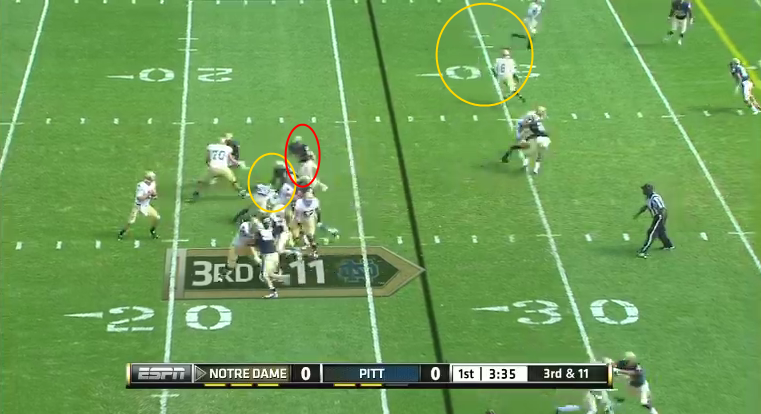
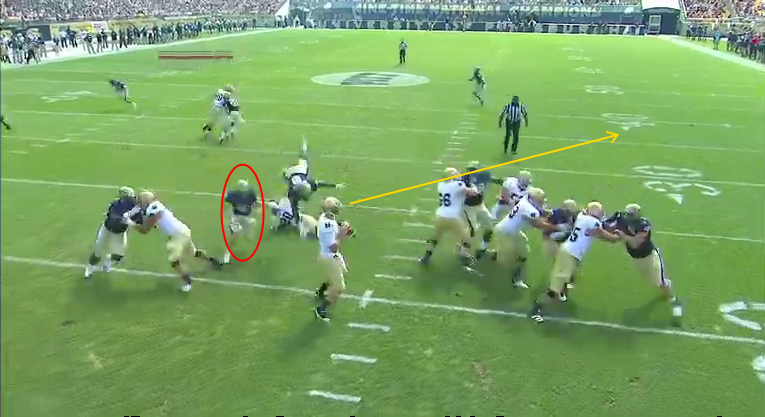
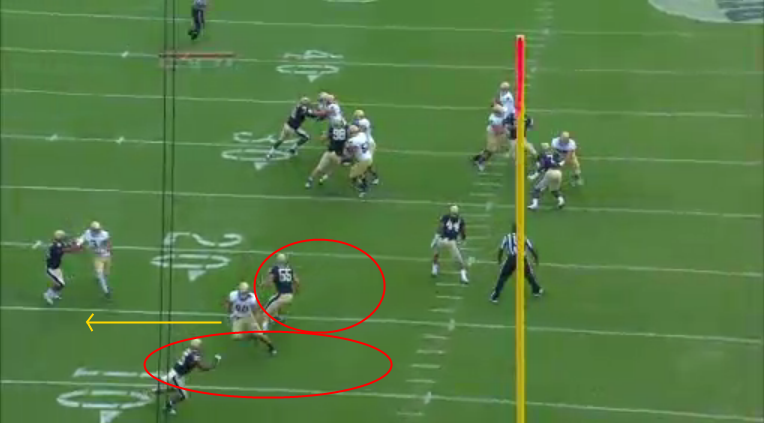
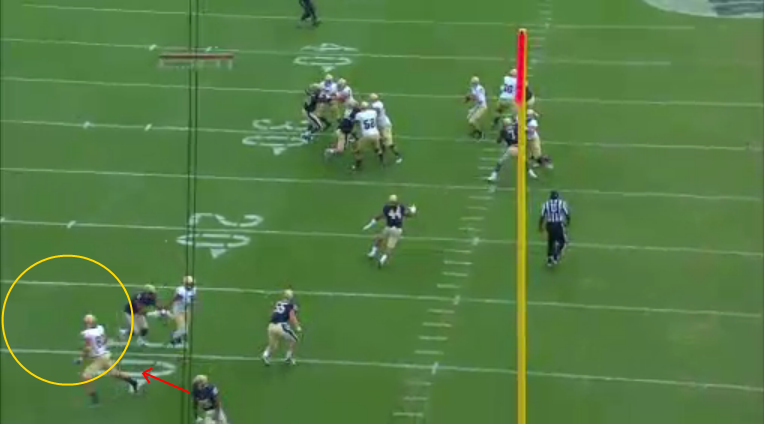
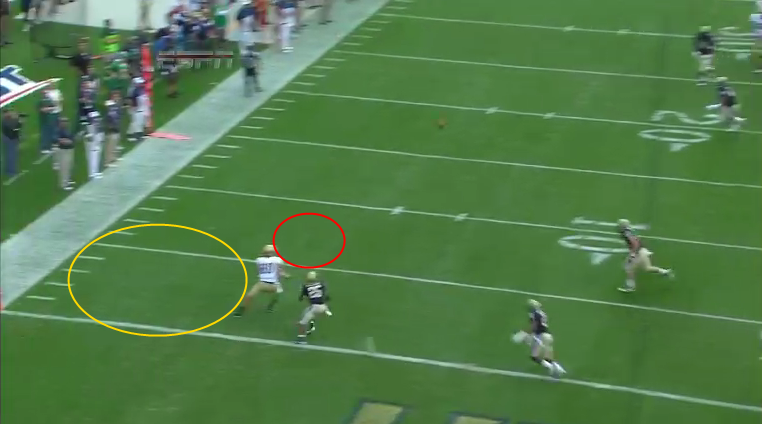
good recap. as i alluded to during the game (on twitter) as well, it’s clear that pitt’s “straight up” pass defense was woefully poor and their best bet was to confuse coverage/blitzes & bait a young/inexperienced QB into making incorrect audibles & reads.
with what you summarized above, what would you have done differently? some options i suggest:
– lock rees into run-only playcalls early to prevent passing audibles into disguised coverages
– rollouts to give him half-field reads & allow him to throw the ball away if nothing develops
– go to hurry-up to prevent defense from rotating personnel
with the combination of turnovers/quick changes and poor punting (which gave the defense a short field), it prevents the opposition from sustaining a drive to score and/or change field position…which would have given offensive staff time to discuss & implement some quick changes.
we saw this situation for the majority of the sc game last year, with linemen dropping into slant routes and knocking down passes at the line of scrimmage. like you, i hope rees starts looking off safeties soon.
as well as our defense played, i also give credit to pitt’s defensive coaches for a good gameplan to confuse our QB, take away our primary receiving weapon, and shorten the game to maximize their chance of victory. it nearly worked.
I think Kelly may need to consider taking the audible privilege away from Rees. It’s important that he gets a chance to do it, but if he is so far off in reading things that Kelly can see clear as day, Kelly should be the one to change plays.
Only other thing to do is really just keep up the film work and practice. As frustrated as we are, it’s hard to remember that Rees is a true sophomore that has less than season under his belt. The mistakes he is making are classic young QB mistakes.
i personally think Rees rolling out is dangerous. i don’t think he’s done well in those types of plays or when he’s been forced to rollout.
I agree with not rolling Rees out.
A) He tends to float….drift….toward the sideline. On a roll out there should be a point where he stops, plants and throws, or heads toward the LOS and throws decisively on the run.
B) His arm strength is not great in the pocket, if he’s on the move, that just makes even weaker. IMHO
not sure if Kelly will take away the ability to call audibles from Rees. I think Kelly values the QB vantage point – and Rees has proven his ability to check into run plays based on coverage – so he’s got that going for him. I’m intrigued with Kuk’s suggestion we go run only a bit, to get a groove going before letting Tommy loose. I too have asked the question as to why we haven’t been able to run the offense as fast as I was led to believe a Brian Kelly operates at.
not sure if Kelly will take away the ability to call audibles from Rees. I think Kelly values the QB vantage point – and Rees has proven his ability to check into run plays based on coverage – so he’s got that going for him. I’m intrigued with Kuk’s suggestion we go run only a bit, to get a groove going before letting Tommy loose. I too have asked the question as to why we haven’t been able to run the offense as fast as I was led to believe a Brian Kelly operates at.
oh and Ryan, great recap.
oh and Ryan, great recap.
Going run heavy like that has happened before: USC. I doubt Kelly will ever take the audible ability away from Rees, but I’d prefer that over another QB switch that isn’t needed.
Going run heavy like that has happened before: USC. I doubt Kelly will ever take the audible ability away from Rees, but I’d prefer that over another QB switch that isn’t needed.
If you’re going to go ahead and break down film then break down the final drive of the first half and the last drive where Tommy went 8 for 8 and threw the go ahead TD.
Why would I do that when the objective of the post was to explain how the turnovers happened and what I meant by Rees locking in his primary option? My analysis of the TD drive would border on nitpicking.
I’m not trying to create a QB controversy or blast Rees. The post is meant to highlight the best examples of Rees playing “sub-par” as Kelly would call it. They are classic mistakes a young QB makes and they are all correctable.
Why would I do that when the objective of the post was to explain how the turnovers happened and what I meant by Rees locking in his primary option? My analysis of the TD drive would border on nitpicking.
I’m not trying to create a QB controversy or blast Rees. The post is meant to highlight the best examples of Rees playing “sub-par” as Kelly would call it. They are classic mistakes a young QB makes and they are all correctable.
I’m glad you broke down what you did as it was informative. But if you’re going to take the time and break down bad plays, break down some good ones so the reader can see what a good play looks like from Rees’ prospective.
I encourage you to start your own website and do just that T-Bone. Just my prospective….
If you’re going to go ahead and break down film then break down the final drive of the first half and the last drive where Tommy went 8 for 8 and threw the go ahead TD.
Very nice breakdown. Thanks!
well presented summary, Tex. And for those griping about “negative” focus, pay attention. This is what’s holding the team back… QB decisions this year are HORRIBLE… one good drive doesn’t offset that.
Crist should turn in his uniform, finish his classes and get out of Dodge, because he is never going to see action again because the coach never makes a mistake (or admits to one ala Tulsa last year).
The QB’s head fake and/or arm pump are effective and easy to teach and execute. I question a DBs ability to see or read the thrower’s eyes. The QB’s stance can be a dead giveaway, however. Shmo
This is nicely done. I will make two points, however. On the sack fumble play, Rees’s reads are undoubtedly long to short. My guess is that he didn’t fail to see Riddick, but he was looking for a throw past the sticks. In hindsight it would have been better to throw the checkdown to Riddick, but he probably would have been tackled short of the sticks and we’d have punted on 4th and 3. In the interception throw, it looked to me like Eifert sat down in what he thought was a hole. If Rees had been a little earlier, that would have helped, but Eifert probably was worried about running out of real estate. In both cases, Tommy could have made better decisions (and will eventually) but there are (as you point out) multiple factors at work.
Not being a know it all, but since I played the position…you that you do not typically have a progression read on a blitz. It’s your hot receiver, and that’s it. The defense shows its soft belly in one spot if they bring six rushers and you need to recognize and release, NOW! You would typically take your chances in the flat that your receiver can elude one man and get to the marker for a first…if not just bust it long. As for the pass to Eifert, I think you are both right, Rees should have both read and thrown that route earlier, and more toward the sideline.
Agreed on the hot route point. You can’t wait for anything to develop. Better to throw the short pass and let Riddick attempt to make a play for the first. A punt is always better than a fumble.
I wouldn’t say “always” given our punting this year, but certainly the vast majority of the time. The way things have gone this year, it probably would have been returned for a touchdown and we would’ve given up 7 instead of 3.
I guess I could have been more clear. (I played a little bit too at that position eons ago, and I was terrible.) I think he might well have not seen where all the blitzers were coming from or (with too much moxie) thought that Wood would pick up the blitz and buy him enough time. It’s hard to say for sure, but it’s a clever blitz because the DB who gets him is actually mostly screened from Rees’s view when Rees is looking that way. (I know in theory that Rees could have deduced this from Riddick being open but at the point he’s looking that way, I’m not sure how well he can see Riddick over Wood and both the defenders.) He really only becomes visible to Rees as he starts to turn to his right. So he might well have seen just one blue shirt, figured Wood had him and that he had time to look the other way and see if he had Floyd beyond the sticks. I agree that if he knew that Pitt had them outnumbered on that side that progressions be damned, you’ve got to get the ball going in the direction of a white shirt with an eligible number that isn’t blanketed by a blue shirt (that being Riddick). Of course, as you know, this is all crystal clear with freeze frames as opposed to about 1 second to make up your mind. My general point about the reads and the down and distance is that when you are forced into those plays where your first reads are downfield (and the defense knows this) bad stuff is more likely to happen.
On the interception play, it’s not clear from the frames but I rewatched it and I think part of the problem is that Rees actually bumps into an OL and delays him getting the ball out.
I’m not trying to excuse Rees. He played badly in the 1st half of the game. There were about 3 other plays that could have been interceptions, including a possible pick 6 on the 1st or 2nd series. Rees needs to play better, but so do some other guys.
Excellent!
I disagree with taking the audibling privileges from Rees. Maybe simplify them a bit, but he has to be able to check out of a play when he sees blitz. Also, he seemed to do a great job of changing plays in the Michigan game, at least through the first 3 quarters.
I love the analysis, wish I saw all of these things during the game. I would say although the interception was a bad throw, he did seem to get hit. So I don’t know if he meant to throw outside and his getting hit hurt him, or if he just doesn’t have the arm strength to make that throw. Either way, again, great analysis!
thanks!! this was really neat, a learning experience for an OLD, trust me, Domer
What’s interesting to me about the first play is that it indicates a lot of confidence on Kelly’s part in Rees’ ability to convert the 3rd down. No draw play, screen, or short crossing route to try to make it a manageable 4th down/long field goal, but instead four vertical routes to stretch the coverage and get somebody open past the sticks.
Also, after re-watching the play online, I’m not so sure Eifert is as open as those still shots make it look. From what I could tell, Pitt was playing Cover 3 man, so there should be another DB somewhere just off camera to the right. Of course, he may not have been in position to make a play if he was more occupied with keeping over top of Floyd on the far right. Either way, I won’t disagree that it’s a better choice than throwing to Riddick there.